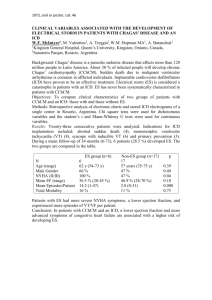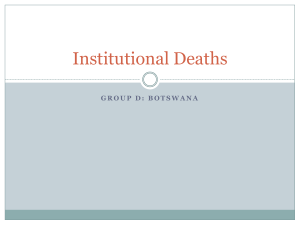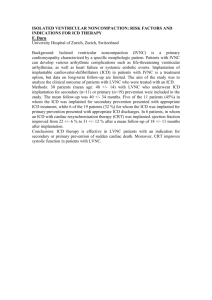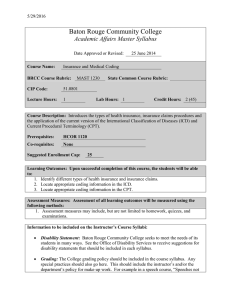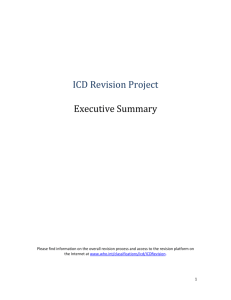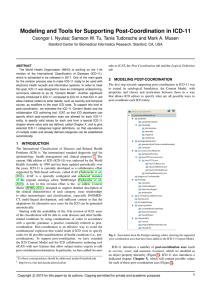WHO Health Statistics: GHO Portal
advertisement
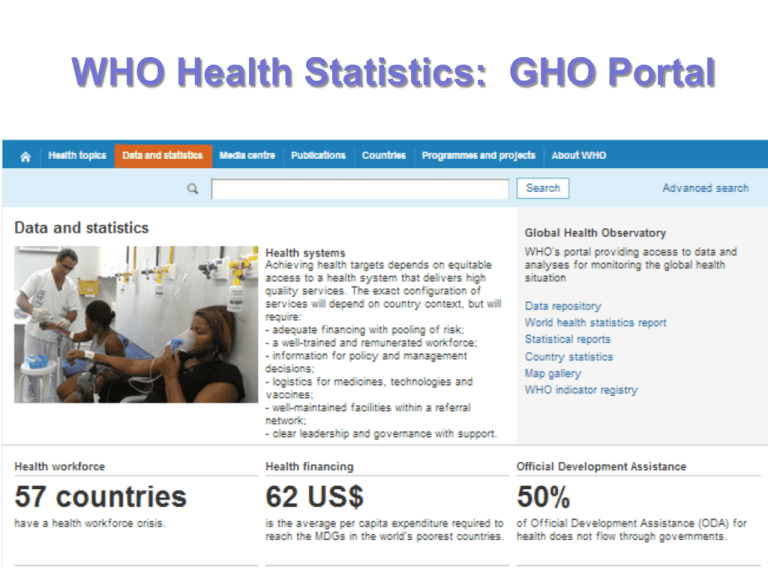
WHO Health Statistics: GHO Portal Global Health Observatory WHO's portal providing access to data and analyses for monitoring the global health situation • Data repository – – – – • • • • • Mortality Millennium Development Goals Burden of disease …. World Health Statistics reports Statistical reports Country statistics Map gallery WHO Indicator Registry NHO KS KS KS KS NHO KS KS KS KS KS KS KS GHO and other observatories KS Information Products African KS Health Profiles Observatory Data KS KS KS Other databases NHO KS KS KS KS KS KS GHO Quality Improvement • Improved data and metadata standards – SDMX implementation - XMART – Indicator Metadata Registry update 2.0 HISP • Improved Visualization Tools • Infrastructure renewal – – – – Regional Health Observatories Country Health Observatories Linked Data initiatives WEB services An Information Paradox: Reporting of Mortality in the World Information Paradox Burden of Mortality 800000000 700000000 600000000 YLLs 500000000 400000000 300000000 200000000 100000000 0 1 VR countries 2 3 vs 4 No VR CAUSES of DEATH ESTIMATES UPDATE para 3 • WHO released regional-level estimates of mortality in July 2013, by: – cause, age and sex – for years 2000 - 2011. • country-level estimates for years 2000-2012 will be released late 2013. • UN Inter-agency Group for Child Mortality Estimation will release Child Mortality estimates in September. Consultation with Member States • WHO reporting is regulated by its Governing Bodies ( Executive Board Resolution EB107.R8 ) • WHO’s main interlocutor, by constitution, is the Ministry of Health in a Member State • WHO encourages the MoH to coordinate with all relevant government agencies, including the National Statistical Offices. Criteria for WHO Official Statistics in line with the general principles of statistics: (1) an accurate listing of data inputs used, with relevant metadata ideally, such data should be publicly accessible (2) correction of known biases in the input data (3) a clear explanation of the modeling approach used, preferably in the peer-reviewed literature (4) country consultation, (if country estimates are to be released). PART 2: ICD Revision Genealogy of ICD 1664 450 years 14,473 100000 ICD-10-M ICD 10 8,173 1,967 1,164 ICD 9 ICD-9-M 1,040 ICD 8 200 ICD 5 965 214 ICD 4 ICD 7 205 ICD 3 954 189 ICD 2 10000 ICD 6 179 ICD 1 1 161 10 Bertillon 100 139 1000 Farr/d'Espine ICD Revisions 1853 1893 1900 1909 1920 1929 1938 1948 1955 1968 1975 1979 1993 1993 Placing WHO Classifications in HIS & IT ICD ICF Linkages KRs e-Health Record Systems ICHI Classifications Terminologies Population Health Clinical • • • • • Births Deaths Diseases Disability Risk factors Administration • Decision Support • Scheduling • Integration of care • Resources • Outcome • Billing Reporting • Cost • Needs • Outcome ICD-11 Revision Goals Evolve a multi-purpose and coherent classification 1. – Mortality, morbidity, primary care, clinical care, research, public health… Consistency & interoperability across different uses – 2. Serve as an international and multilingual reference standard for scientific comparability and communication purposes 3. Ensure that ICD-11 will function in an electronic environment. • • ICD-11 will be a digital product Support electronic health records and information systems • Link ICD logically to underpinning terminologies and ontologies (e.g. SNOMED, GO, …) • ICD Categories “defined” by "logical operational rules" on their associations and details Construction of ICD-10: Revision Process in 20th Century • 8 Annual Revision Conferences (1982 - 89) • 17 – 58 Countries participated – 1- 5 person delegation • Manual curation – List exchange – Index was done later • "Decibel" ? Method of discussion • Output: Paper Copy • Work in English only • Limited testing in the field Construction of ICD-11: Revision Process in the 21st Century • Internet-based permanent platform – All year round – Open to all people in a structured way – Content experts focus • Digital curation – Wiki enabled collaboration – Ontology based • Enhanced discussion & peer review – TAGs serve as the editorial group • Electronic copy print version • Work in multiple languages • Planned field tests – Based on Use Cases How do we go from Here to 21st Century? • Open and Collaborative Platform – Web based – Like WIKI • But – by the Content Model • with – by the TAGs , and scientific peers What is Ontology? Ontology (philosophy) – the Organization of Reality Ontology (computer science) – the explicit – operational description of the conceptualization of a domain: An ontology defines: – a common vocabulary a shared understanding/exchange: among people among software agents between people and software – to reuse data - information – to introduce standards to allow interoperability ICD11 βeta • http://www.who.int/classifications/icd/revision • Beta – Browser & Print 10 look & feel + descriptions – code structure ! βeta • ICD-11 Beta draft is NOT FINAL • updated on a daily basis •NOT TO BE USED for CODING except for agreed FIELD TRIALS ICD-11 Features Internet Based Platform Input from all Stakeholders Content Model Definitions Field Trials for Use Cases Electronic Health Record Ready لعربية 官话 English Français Multi Lingual Representations Arabic Chinese English French Русский язык Russian Español Spanish Deutsch Português German Portuguese FIELD TESTS (1): Bridge-Coding • The Case information • live • medical record • Coded using • ICD10 • ICD11 • Agreement rates measured FIELD TESTS (2): Reliability • The Case information • live • medical record • Coded using ICD11 by at least two different people • Agreement rates measured ICD-11 Timeline • 2011 : Alpha version ( ICD 11 alpha draft) – +1 YR : Commentaries and consultations • 2012 : Beta version & Field Trials Version – +3 YR : Field trials • 2015 : Final version for WHA Approval – 2015+ implementation ICD-10 ICD-11 • Annual Revision Conferences • Continuous web platform + meetings • Focus on mortality statistics • Focus on ALL statistical use cases • Produced manually • Produced digitally – w/ information model • Produced in English • Multilingual development • NO field tests • Field tests done before • Update mechanism built in later • Continuous update – revision mechanism Questions & Answers ustunb@who.int @ustunb
